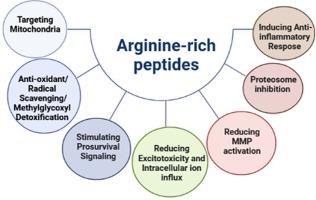Neuropeptides ( IF 2.9 ) Pub Date : 2023-06-23 , DOI: 10.1016/j.npep.2023.102356 Sedigheh Eskandari 1 , Ameneh Rezayof 2 , S Mohsen Asghari 3 , Shiva Hashemizadeh 4

|
Neurodegenerative diseases, including Alzheimer̕ s disease (AD), Parkinson̕ s disease (PD), Huntington̕ s disease (HD), and Amyotrophic Lateral Sclerosis (ALS) require special attention to find new potential treatment methods. This review aims to summarize the current knowledge of the relationship between the biochemical properties of arginine-rich peptides (ARPs) and their neuroprotective effects to deal with the harmful effects of risk factors. It seems that ARPs have portrayed a promising and fantastic landscape for treating neurodegeneration-associated disorders. With multimodal mechanisms of action, ARPs play various unprecedented roles, including as the novel delivery platforms for entering the central nervous system (CNS), the potent antagonists for calcium influx, the invader molecules for targeting mitochondria, and the protein stabilizers. Interestingly, these peptides inhibit the proteolytic enzymes and block protein aggregation to induce pro-survival signaling pathways. ARPs also serve as the scavengers of toxic molecules and the reducers of oxidative stress agents. They also have anti-inflammatory, antimicrobial, and anti-cancer properties. Moreover, by providing an efficient nucleic acid delivery system, ARPs can play an essential role in developing various fields, including gene vaccines, gene therapy, gene editing, and imaging. ARP agents and ARP/cargo therapeutics can be raised as an emergent class of neurotherapeutics for neurodegeneration. Part of the aim of this review is to present recent advances in treating neurodegenerative diseases using ARPs as an emerging and powerful therapeutic tool. The applications and progress of ARPs-based nucleic acid delivery systems have also been discussed to highlight their usefulness as a broad-acting class of drugs.
中文翻译:

富含精氨酸的肽的神经生化特征解释了它们在神经退行性疾病中的潜在治疗功效
神经退行性疾病,包括阿尔茨海默病(AD)、帕金森病(PD)、亨廷顿病(HD)和肌萎缩侧索硬化症(ALS)需要特别关注,以寻找新的潜在治疗方法。本综述旨在总结目前对富含精氨酸肽(ARP)的生化特性与其神经保护作用之间关系的认识,以应对危险因素的有害影响。ARP 似乎为治疗神经退行性疾病相关疾病描绘了一幅充满希望和奇妙的前景。凭借多模式的作用机制,ARP 发挥着各种前所未有的作用,包括作为进入中枢神经系统(CNS)的新型递送平台、钙内流的有效拮抗剂、针对线粒体的入侵分子以及蛋白质稳定剂。有趣的是,这些肽抑制蛋白水解酶并阻止蛋白质聚集,从而诱导促生存信号通路。ARP 还可以作为有毒分子的清除剂和氧化应激剂的减少剂。它们还具有抗炎、抗菌和抗癌特性。此外,通过提供有效的核酸递送系统,ARPs可以在基因疫苗、基因治疗、基因编辑和成像等各个领域的发展中发挥重要作用。ARP 剂和 ARP/货物疗法可以作为一类新兴的神经退行性神经治疗药物。本次综述的部分目的是介绍使用 ARP 作为新兴且强大的治疗工具治疗神经退行性疾病的最新进展。还讨论了基于 ARP 的核酸递送系统的应用和进展,以强调它们作为一类广泛作用的药物的有用性。



























 京公网安备 11010802027423号
京公网安备 11010802027423号